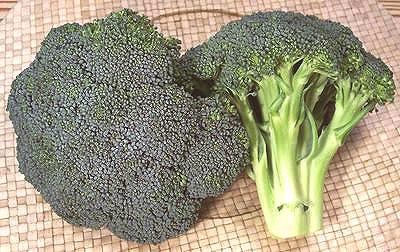 [Broccoli; Brócolis americano (Brazil); Xi Nan Hua Cai (China,
lit. Flower Vegetable from the Southwest); B. Brassica oleracea
Group Italica]
[Broccoli; Brócolis americano (Brazil); Xi Nan Hua Cai (China,
lit. Flower Vegetable from the Southwest); B. Brassica oleracea
Group Italica]
Broccoli was probably known in Roman times, though it probably looked much more like today's Chinese Broccoli. It continued to be developed by growers to produce the large flower heads we know today. These heads are harvested and eaten well before maturity because they will open into yellow flowers and become mushy and bitter. This broccoli has recently started appearing in China, where it has been enthusiastically accepted.
Like other cabbages, broccoli is high in fiber, vitamin C, antioxidants and is suspected of significant anticancer benefits. The photo specimens were about 5-1/2 inches across, 5-1/2 inches long and weighed 13 ounces. Broccoli is often sold in narrower heads and/or with longer stems.
More on Cabbage Flowers.
Select broccoli heads that are very dark in color and firm, and the stems should be crisp and not at all rubbery. Flower heads may be dark green or have a bluish or purplish cast. Over aged broccoli will start to yellow, the flower heads will start to loosen and soften, and the flowers will start to open. At this point it will be bitter and cook mushy.
Broccoli leaves are very edible, but have generally been stripped off in the markets. The reason is, leaves yellow sooner than the flower heads and they want long shelf life. If any small ones are attached they can be cooked along with the florets. If you need leaves, use Chinese Broccoli (rappini / broccoli rabe is a turnip green).
Broccoli should be refrigerated in a loose plastic bag and should be used within one to five days depending on original condition.

The best way to cook broccoli is in a steamer. Placed over already boiling water, florets with short split stems should be tender in 5 to 7 minutes. If you are using slices of stem, give them about 2 minutes lead over the florets.